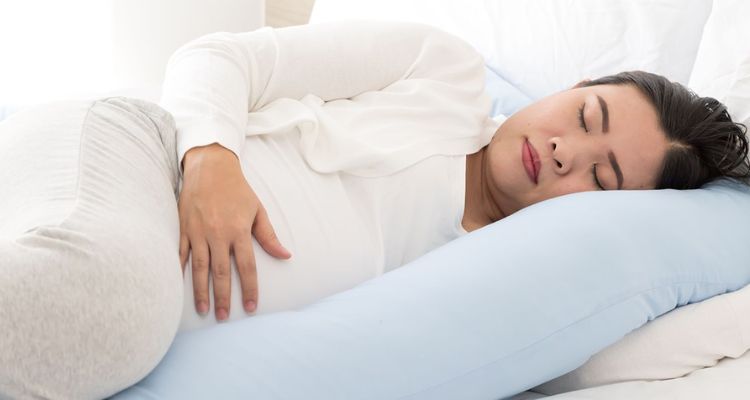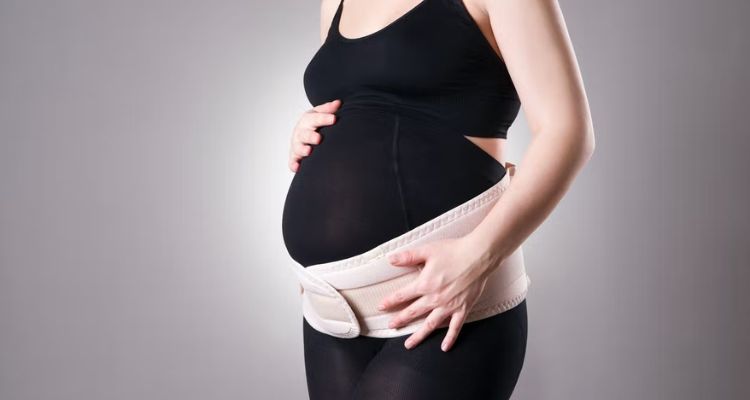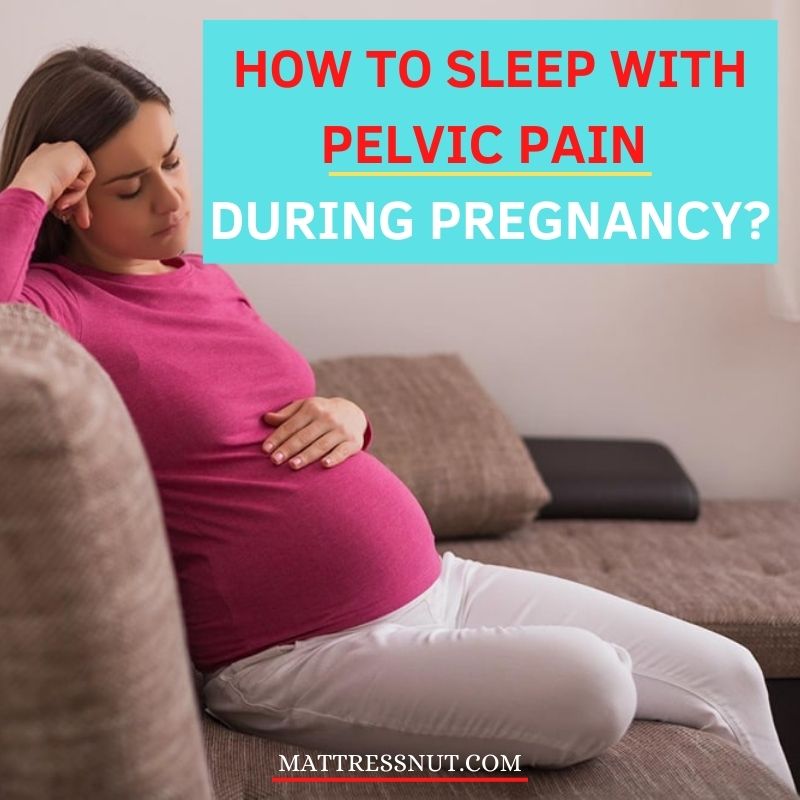For most pregnant women, sleeping is a difficult task (also check the top rated mattresses for pregnancy). It is even more complicated when they suffer from pelvic pain. Many women experience pelvic pain during pregnancy, and it is considered normal. The additional weight of the growing fetus puts pressure on the spinal column and causes pain. As a result, getting a restful night’s sleep can be difficult.
Let’s check out some of the tried and tested solutions about how to sleep with pelvic pain during pregnancy. An alternative or a remedy for the issue is handy as every pregnant woman has to face it at some point.
What Causes Pelvic Pain during Pregnancy?
Pelvic Pressure
The growing baby’s weight causes pelvic pressure during pregnancy. The uterus starts pressing down on the pelvic bones and muscles, creating tension. This can initiate pain in the lower back, hips, and thighs. The pain may be worse when you stand for long durations, sit for long periods, or make a sudden movement. You may experience pain whenever you have to go or make a bowel movement.

Round Ligament Pain
During pregnancy, the round ligaments are two muscle bands supporting the uterus. As the uterus grows, the round ligaments on the sides stretch. This results in pain in the lower abdomen or pelvic area. This pain is often worse when you change positions, such as sitting to standing or lying down to sitting up.
The pain can worsen at night or after a hectic day. Round ligament pain is a common annoyance during pregnancy. It is an inevitable experience and is usually nothing to worry about. However, you should talk to your doctor if the pain is relentless or persistent.
Symphysis Pubis Dysfunction
Symphysis Pubis Dysfunction (SPD) is a syndrome that can cause pelvic pain during pregnancy. SPD occurs when the ligaments that connect the pubic bones loosen, allowing the pubic bones to move apart. This can cause pain around the pelvic, as well as pain in the spine, hips, and legs.
There are several explanations for SPD, including:
- Pregnancy hormones
- Weight gain
- Changes in the position of the pelvis.
SPD is more frequent in women who are expecting twins or multiples. It is also in women who have had previous pregnancies.
Treatment for SPD includes:
- Wearing a pelvic support belt
- Doing pelvic exercises
- Avoiding activities that strain the pelvis
Braxton Hicks Contractions
During pregnancy, Braxton Hicks contractions can cause pelvic pain. These contractions are caused by the uterus contracting and can be pretty intense. They can invoke pain in the lower abdomen or back and can be very uncomfortable.
Symptoms of Pelvic Pain during Pregnancy
Pelvic pain during pregnancy can be a symptom of several conditions. It can be SPD, endometriosis, uterine fibroids, or even plain old pregnancy-related back pain.
The pain can range from mild and intermittent to severe and chronic. It may be localized to the pelvis or radiate to the lower back, hips, or legs.
Pelvic pain can make walking, sitting, or standing difficult for long durations. It can meddle with a woman’s ability to do her everyday activities.
How to Relieve Pelvic Pain during Pregnancy
Use a Pregnancy Support Belt
Pregnancy means the bones and muscles will expand and stretch. These changes in the mother’s body can lead to pain in the pelvic region. One way to help alleviate that pain is to use a pregnancy support belt. These belts support the lower back and abdomen and can help take some pressure off the pelvis. Additionally, they can help redistribute weight more evenly, which can help reduce pain.

Use a Pregnancy Pillow
If you’re experiencing pelvic pain during pregnancy, you may want to try using a pregnancy pillow (check 7 top rated organic pregnancy pillows). These pillows are exclusively designed in various shapes and thicknesses. They provide support and relief for your back, hips, and belly.
There are a variety of pregnancy pillows available. They come in different shapes, sizes, and firmness. You’ll want to choose one that’s more comforting for you (check the most comfy pillows). You may want to try a pillow with a firmness level that is most suitable to provide the level of support you need.
Talk to your midwife if you’re unsure which pregnancy pillow is right for you. They can help you choose a pillow that will offer the most support and relief for your situation.
Lay Down
Laying down is always good to ease pressure from the abdomen. Try placing a pillow between your thighs when you lay down. You can also use a pregnancy pillow to alleviate your back and belly pressure. Pregnancy pillows are specifically designed to support various body parts during pregnancy.
Though laying down seems like a good option, sometimes, an awkward position of the fetus can take the pleasure away. Some pregnant women, at some point, find it uncomfortable to lie down on any of their sides.
Go To a Chiropractor or Massage Therapist
You may consider visiting a chiropractor or massage therapist. Chiropractic care relieves pelvic pain and pain from other joints as well. Similarly, massage therapy can help reduce pain and tension in the pelvic area.
You need to ensure that the Chiropractor or the massage therapist is professional. They should be aware of the issues related to pregnancy and pregnant women.
Exercise
Several things can cause pelvic pain during pregnancy. It can be round ligament pain which most pregnant women experience during the second trimester. Moreover, it could be due to the strain on the nerves in the pelvis. It might be because the baby’s head presses down on the pelvis.
Exercise can help relieve this pain by strengthening the pelvic and pelvic floor muscles. It can help to support the baby’s weight and relieve pressure on the nerves.
Many different exercises can help relieve pelvic pain during pregnancy. One is pelvic tilts, which can help to pull out the muscles in the lower back and pelvis.
The second exercise that can help is Kegel. It can help to build the pelvic floor muscles.
Consult with your gynecologist or midwife about what exercises might be best for you according to the severity of the pain.
Take a Warm Bath
Pregnancy is the epitome of changes in the body and life. These developments in the body can cause all sorts of new aches and pains, including pelvic pain. Warm water can help to calm the muscles and ease the pain. Just be sure not to stay in the tub for too long, as overheating can be dangerous for you and your baby.
Simple pelvic pain may be a sign of something minor or major. In some cases, pelvic pain is a traditional part of pregnancy and will resolve independently. However, seeking professional help is essential if the pain is persistent.
Home Remedies to Reduce Pelvic Pain during Pregnancy
Rest when needed – do not push yourself too much. Nobody is expecting a perfect home or job from you. Resting is essential and gives you time to recharge.
Exercising in water is an excellent way to stay fit while pregnant. The ability to float and feel weightless helps remove the tension from your joints. Aqua aerobics and swimming laps are great options for expectant mothers to exercise harmlessly.
You can reduce inflammation in your pelvic joints by placing an ice pack on them.
Key Takeaways
1. Causes of Pelvic Pain
Several factors can lead to pelvic pain during pregnancy, including:
- Pelvic Pressure: This arises from the growing weight of the fetus, which applies pressure on the pelvic bones, muscles, and the spinal column. Activities like prolonged standing or sudden movements can exacerbate this pain.
- Round Ligament Pain: As the uterus grows, the two muscle bands known as the round ligaments stretch, causing pain in the lower abdomen or pelvic region. This discomfort intensifies when changing positions.
- Symphysis Pubis Dysfunction (SPD): SPD causes the pubic bones to move apart due to loosening ligaments, resulting in pain in the pelvic area and beyond. Factors like pregnancy hormones, weight gain, and pelvic changes contribute to its occurrence.
- Braxton Hicks Contractions: These contractions can be intense and invoke pain in the lower abdomen or back.
2. Symptoms of Pelvic Pain
Pelvic pain during pregnancy can manifest as:
- Mild to severe discomfort
- Localized pain in the pelvis or radiating pain to the back, hips, or legs
- Difficulty in prolonged standing, walking, or sitting
- Disturbance in performing daily activities
3. Solutions for Pelvic Pain Relief
There are several strategies pregnant women can employ to alleviate pelvic pain:
- Pregnancy Support Belt: These belts help in supporting the lower back and abdomen, redistributing weight evenly and taking pressure off the pelvis.
- Pregnancy Pillow: Specialized pillows offer support for the back, hips, and belly, helping in relieving pain.
- Lay Down: Laying down, especially with a pillow between the thighs, can help ease pelvic pressure.
- Chiropractic or Massage Therapy: Professional chiropractic care or massage therapy can provide significant relief.
- Exercise: Exercises like pelvic tilts and Kegel exercises can strengthen the pelvic muscles and offer relief.
- Warm Bath: A warm bath can soothe the muscles and help in easing pain, but prolonged exposure should be avoided.
4. Home Remedies for Pelvic Pain
There are some additional tips pregnant women can consider:
- Rest when needed
- Opt for water-based exercises like aqua aerobics
- Use an ice pack to reduce inflammation
- Ensure proper hydration and avoid constipation
Conclusion
If you’re experiencing pelvic pain during pregnancy, you’re not alone. According to the American Pregnancy Association, up to 75 percent of pregnant women experience this symptom. At some point during their pregnancy, pelvic pain becomes regular. While pelvic pain is common, it can be quite uncomfortable. You can switch to exercising, cushioning with pillows, massaging, or using the belt. The comfort level achieved varies with each practice and from woman to woman.
References:
https://pubmed.ncbi.nlm.nih.gov/24913201/
https://www.nhs.uk/pregnancy/related-conditions/common-symptoms/pelvic-pain/
https://www.nct.org.uk/pregnancy/exercise-and-fitness/pelvic-floor-and-stomach-exercises-pregnancy
Sleep with pelvic pain during pregnancy FAQs
What Helps Pelvic Pain at Night during Pregnancy?
A few things can help reduce pelvic pain during pregnancy, particularly at night. Sleeping on your side, especially your left, takes the pressure off your pelvic area. A small pillow between your knees or legs can support your hips and pelvis.
Wearing a pregnancy support belt is another helpful tip. It works by holding the pelvis in alignment and reducing the pain. Finally, stay hydrated and avoid constipation, as both can contribute to pelvic pain.
Why Is Pelvic Pregnancy Pain Worse At Night?
Pregnant pelvic pain is worse at night, and there are many reasons. It is because the baby's position in the womb puts pressure on the nerves and blood vessels in the pelvis. This can cause uneasiness, which is often worse at night when lying down.
Pelvic pain can be caused by the constantly growing uterus pressing on the pelvic floor muscles. This can be alleviated by pelvic floor exercises and using a pregnancy support belt.
Can Pelvic Pain Cause Bedrest?
Pelvic pain is a common symptom in pregnant women, ranging from mild to severe. In some cases, pelvic pain can warn of a more concerning condition, such as preterm labor. If that is the case, then bedrest and exemption of specific tasks may be recommended.
Bed rest is one of the ways to help manage the pain and prevent further complications. While bed rest can effectively manage pain, it is important to understand all the options. Before deciding, you need to understand the risks and benefits of bed rest. Sometimes prolonged bed rest may lead to delayed labor or a C-section.
Does Laying Down Make Pelvic Pain Worse?
Every pregnant woman experiences pelvic pain differently. For some people, lying down may worsen the pain, while it may provide some relief for others.
Experimenting with different positions and activities is vital to see what suits you. If lying down makes your pelvic pain worse, you may want to try sitting up or standing instead. Some people find pelvic pain worse when inactive, so gentle exercise may help.

